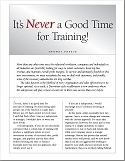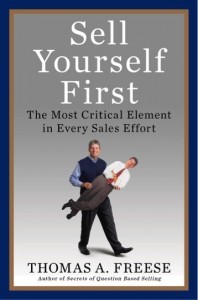Thomas A. Freese's Blog, page 5
May 25, 2017
NEVER a “Good Time” for Sales Training
 More than any other time since the industrial revolution, companies and salespeople in all industries are working at a feverish pace to find ways to retain customers, boost top line revenue, and maintain profit margins.
More than any other time since the industrial revolution, companies and salespeople in all industries are working at a feverish pace to find ways to retain customers, boost top line revenue, and maintain profit margins.
To survive and ultimately flourish in today’s rapidly changing business environment, it may be time to reexamine the way sellers deal with prospective customers–and frankly, some of the adjustments that need to be made are long overdue.
It’s NEVER A Good Time for Training
 More than any other time since the industrial revolution, companies and individuals in all industries are feverishly looking for ways to retain customers, boost top line revenue, and maintain overall profit margins.
More than any other time since the industrial revolution, companies and individuals in all industries are feverishly looking for ways to retain customers, boost top line revenue, and maintain overall profit margins.
To survive and ultimately flourish in this new environment, we must reexamine the way we deal with customers; and frankly, some of the necessary adjustments are long overdue.
May 19, 2017
Traditional Rapport-Building is Overrated
 Being outgoing, gregarious, and friendly used to be the savvy salesperson’s ticket to penetrating new accounts. Today, key decision makers on your target list of prospects already have plenty of friends. And, given the sheer volume of solicitations that come in on a daily basis, it shouldn’t surprise anyone that the next cold call that gets lobbed in the customer’s direction has only a very small chance of success.
Being outgoing, gregarious, and friendly used to be the savvy salesperson’s ticket to penetrating new accounts. Today, key decision makers on your target list of prospects already have plenty of friends. And, given the sheer volume of solicitations that come in on a daily basis, it shouldn’t surprise anyone that the next cold call that gets lobbed in the customer’s direction has only a very small chance of success.
Some of the reason sellers are experiencing such low hit-rates is self-inflicted, by using traditional catch-phrases like, “I would love to…”, or, “I just need a brief moment of your time.” Decision makers know you’re not just looking for a brief moment of their time. They also assume salespeople have quotas to hit and would really “love” to boost their commissions.
No doubt your intentions are good, as most salespeople are earnestly trying to provide value to their customers. The challenge is separating yourself from the countless other solicitations potential buyers receive on a daily basis, and then causing decision makers to “want to” engage with you.
Suppose if it were possible to reverse this trend. What if you could create an 80%+ success rate when reaching out to new prospects, rather than continue enduring the typical 90%+ failure rate? How is this possible, you might ask?
Acquiring the skills necessary to fill your pipeline faster, and with more qualified prospects, is actually easier than one might think. But, it does require sellers to have an appreciation of next-generation selling skills, which is very different than just trying to ‘buddy’ your way into potential opportunities.
There’s no magic, and God knows old-school sales tricks or gimmicks aren’t going to work moving forward. Instead, there are a few very important questions individual sellers (and entire sales teams) should be asking themselves, like:
• What are you doing to leverage curiosity to get mindshare from key decision makers in target accounts?
• What Diagnostic Questions™ are you asking to convey credibility?
• How does opening with a generic elevator pitch differentiate you from competitors who are making similar claims?
• What are you doing to secure incremental commitments on the way to the larger sale?
When you’re on the receiving end of cold calls at home, I bet you’re not excited about giving information to people you don’t yet know and trust. So, why should we expect the old-school mentality of trying to “befriend” prospective customers, if that strategy no longer works on you or me? Hmmm…
May 12, 2017
Tom Freese’s Latest Book is a Game Changer!
width:490px;
margin: auto;
border: 1px solid red;
background: #8C191C;
color: #FFFFFF;
font-family: Arial;
font-style: italic;
font-weight: bold;
font-size: 14px;
text-align: left;
padding: 4px;
}
.offer {
background-color: #eee;
border: 2px solid #ddd;
-moz-border-radius: 5px;
-webkit-border-radius: 5px;
-moz-box-shadow: 0 1px 5px #999;
-webkit-box-shadow: 0 1px 5px #999;
border-radius: 5px;
box-shadow: 5px #ccc;
width: 400px;
text-align: center;
padding-top: 15px;
}
WARNING: Salespeople and sales managers will love this book, but
old school sales trainers are going to hate me for having written it.
Have you noticed that the overall business environment has changed dramatically over the years, yet the world of sales training has remained surprisingly stagnant? That’s about to change in a BIG way with the release of Tom Freese’s latest and most comprehensive addition to the QBS books series.


$14.00
(Click to Save 50%)
(Paperback)
$19.95

SalesForce 2020 is the only book of its kind. It’s a book about the future. While hindsight may be 20/20, it has become increasingly clear that many of the older school selling tactics that have been accepted and touted for decades no longer make sense as we rapidly approach the year 2020.
This raises two important questions that sellers in every industry must consider:
1.) “Do you want to continue struggle with what “used to work” in days gone by, or would you rather focus on what’s going to give you the greatest selling advantages moving forward?”
2.) Might it be time for an overhaul, or to at least upgrade your current approach?”
There’s a reason why top performing salespeople excel, while those who are struggling continue to struggle…even though they are all following the same basic sales process. It’s because just identifying the steps of the sales process is no longer a differentiator. All of your competitors have a sales process in place too, and theirs is probably very similar (if not identical) to yours.
Today, salespeople and managers are hungry for specific sales strategies and selling techniques that will give them an ‘unfair’ advantage in their respective markets, rather than reverting back to the outdated logic that has plagued traditional sales approaches for the last 30+ years.
SalesForce 2020 is a must read for anyone engaged in today’s rapidly changing sales environment. The book flows like you’re having a one-on-one conversation with Tom. Definitely a break-through in how to execute more effectively moving forward!
—Richard Brock, CEO
SalesTalk Technologies
Is this book an indictment of old school sales methods? In a word—Yes. It’s also a road map to show sellers how to gain a proven and differentiable advantage moving forward. Enjoy!
Come Join the Next Generation of Sales Enablement.
May 10, 2017
Audio: The Herd Theory
 My first book created quite a stir when one of the chapters started off with this sentence: Traditional reference selling is highly overrated.
My first book created quite a stir when one of the chapters started off with this sentence: Traditional reference selling is highly overrated.
That statement shocked the establishment as virtually every sales training program created in the last 30 years talks about the importance of leveraging references in the sales process.
References are important—but so is differentiation; and it’s no longer an effective to use references just like everyone else. In Question Based Selling, our goal is to show sellers how to be different from everyone else. One way to accomplish this is to create a sense of momentum in your sales using The Herd Theory—which is a technique that ironically leverages “everyone else.”
CLICK PLAYER TO LISTEN
DOWNLOAD
May 1, 2017
Tom Freese vs. Other Motivational Speakers
Check out this video excerpt where Tom speaks about the difference between motivational speakers, and instead, actually teaching salespeople how to be exponentially more effective.
Sales organizations used to try and motivate salespeople as a way to increase productivity. Today, the opposite is true. If you take the time to show salespeople how to be exponentially more effective, they will absolutely be motivated to repeat their successes. I don’t about you, but to me, there’s nothing more fun or rewarding that having an ‘unfair’ advantage throughout the sales process.
“Zig Ziglar is still the king of the podium, although sadly, he passed away just recently. I can say, however, he was by far the best motivational speaker I have ever heard. But as with other motivation speakers, my problem was, after I went back out into my territory all excited and ready to conquer the world, when I naturally reverted back to using the same old approach, I got the same lousy results. Thus, my newfound levels of enthusiasm tended to dissipate very quickly.” - T. Freese
April 27, 2017
You’re Always Vying for Second Place
In my fifth selling book, Sell Yourself First, Chapter 2 is called: “Your Next Job Interview,” which talks extensively about the need to always be selling yourself. In fact, the job interview scenario serves up the perfect metaphor, because in addition to being responsible for selling yourself, you are also the product that’s being sold.
That said, here’s a strange tip coming from a sales trainer. If you are pursuing an exciting new opportunity in the job market, then I would advise you to position for second place.
There’s usually no such thing as the perfect candidate. The “perfect” candidate would always have more experience and a better track record. They will have also had more training and better references. Add to that the fact they may have been the valedictorian in college, a former Miss America, or a decorated war veteran, and alas, you have the perfect candidate!
It’s actually fine to have weaknesses. More than likely you’re not competing against perfection, anyway. Rather, you’re competing against other candidates who have a resume full of strengths and weaknesses. You just need to make sure that the combined total of your strengths, minus any perceived weaknesses, is greater than whoever else is applying for the job.
I actually think it puts you in a strong position to verbally acknowledge the fact that you’re not perfect. The goal isn’t to sound negative or pessimistic. But, I can tell you that I would be quick to say to a hiring manager, “There probably is no such thing as the perfect candidate for this position. While my strengths include aaaaa, bbbbb, and ccccc, I would want to focus my energy on developing my skills in the areas of yyyyy and zzzzz in order to become productive as quickly as possible.
Most decision makers are realistic and are comforted by the fact that a candidate (or salesperson) is aware that there are some areas that need more attention than others. In fact, a willingness to acknowledge and focus on one’s weaknesses may just be one of your greatest strengths.
The moral to this story is simple. The perfect candidate for a job will always win hands down. Therefore, you are really vying for second place–which includes those times where there is no such person as ‘the perfect candidate.’ If you can elevate yourself to be perceived as the best out of those who do have strengths and weaknesses, then I can tell you with a high degree of confidence that you will win most of the time.
By the way, in a competitive marketplace, there’s no such thing as a “perfect” solution. Think about it!
April 20, 2017
The Least Taught Profession in the World: Sales
As I was preparing to work with a new client–one of the many who has recently adopted The Challenger Sale concepts–I spotted an article in last week’s Sunday paper called “Building a Better Teacher.” Since one of the main tenants of The Challenger Sale is to Teach, Tailor, and Take Control, I read it with interest. There was one passage in particular that got my attention. The passage simply read:
“The natural born teacher has proven to be a myth. Those studies looking for the personality traits of a great teacher don’t pan out. Researchers have found that the most effective teachers can be extraverts–or they can just as easily be introverts. Some are humorous, but others are serious. Some are as flexible as rubber, and others are as rigid as a ruler. It’s not personality that makes a teacher great, but a specialized body of knowledge that must be learned–and that often goes against what comes naturally.”
From my perspective, that same conclusion can be applied to sales. There are very few naturally born salespeople. Success in selling is a function of having the skills necessary to cause prospects to “want to” engage with you, as opposed to the countless other sales callers, coupled with the ability to earn credibility, convey value, create a sense of urgency, qualify, secure commitments, etc. Other than attending a few seminars and whatever experiences you’ve had, how are people who are given the responsibility of producing revenue supposed to learn how to sell?
If we dig deeper, we quickly discover that sales is the least taught profession in the world. To become a practicing attorney, for example, you must first pass the Bar exam. To become a licensed pharmacist, you must pass the boards in the state in which you wish to practice. Accountants, doctors, architects, and professional engineers all must pass some kind of competency test in order to call themselves a professional. Even kindergarten teachers must complete their master’s degree within ten years to continue in their jobs.
What do you have to do to become a sales professional? The answer is: print business cards. In the state where I live (Georgia), you have to have a license to catch a fish or own a dog, but you can sell nuclear parts without any sales training whatsoever. Something about that doesn’t seem right.
When our oldest daughter graduated from the University of South Carolina three years ago, as we sat in the stands waiting for her name to be called, it occurred to me that all of those kids wearing caps and gowns (or their parents) have invested $100K+ to get an education and presumably a head start into their chosen careers, yet the very first thing they will have to do right out of school is to sell–themselves. And the kicker is, after 17 years of formal education (13 years of regular school, and then 4 years of college), most of these graduates haven’t been taught the first thing about how to sell, even though sales is the fuel thing drives revenue in every company. Furthermore, one’s ability to communicate effectively will not only affect their ability to land that first job, it will likely determine their success in life. Hmmm.
There are so many sales training courses out there that it has become VERY unclear as to which option will provide the best fit, especially given all the conflicting information floating around the marketplace.
While some of the more well known courses like Solution Selling, Strategic Selling, Value Selling, SPIN Selling, Target Account Selling, and Power-Base Selling focus on defining the sales process, sellers are left to their own devices to figure out “how” to execute the various objectives that have been defined. This creates a series of questions like:
– How can I succeed when decision makers are more standoffish toward vendors than ever before?
– How can I differentiate yourself when everyone is using the same industry buzzwords?
– How can I create a sense of urgency so that internal champions are able to secure approval?
– How can I get deeper, wider, and more strategic within your current accounts?
– How can “I” increase my R.O.I.S.E (Return on Invested Sales Effort)?
For some unexplainable reason, sellers are expected to know the answers to these and other questions that deal with execution and productivity. Really? Wouldn’t it make more sense to teach best practices so that your entire sales team can take a giant leap forward as opposed to slowly ramping up via trial and error? Ironically, this thought was the genesis of QBS.
In two days or less, we can give sellers an unfair advantage in their respective markets just by teaching them superior strategy using specific sales techniques. And even though some of these techniques “go against what comes naturally,” if a salesperson tries something new and different and it works over and over, it will become natural to them very quickly.
Now the question is, what are we waiting for? When sales managers call me and we go back and forth looking at the calendar to figure out when they want to schedule their training, I ask, “Rather than worry about logistics, can I ask, when would you like to see a significant boost your sales team’s production?” The most common answer is…yesterday.
Does any of this sound familiar? Let me know how we can help.
April 15, 2017
Free Audio: Gold Medals vs. German Shepherds
 “I go fishing up in Maine every summer,” Dale Carnegie wrote in the mid 1930s. “Personally, I am very fond of strawberries and cream, but I find that for some strange reason, fish prefer worms. So when I go fishing, I don’t think about what I want. I think about what they want. I don’t bait the hook with strawberries and cream. Rather, I dangle a worm, or a grasshopper, in front of the fish saying, ‘Wouldn’t you like to have that?’”
“I go fishing up in Maine every summer,” Dale Carnegie wrote in the mid 1930s. “Personally, I am very fond of strawberries and cream, but I find that for some strange reason, fish prefer worms. So when I go fishing, I don’t think about what I want. I think about what they want. I don’t bait the hook with strawberries and cream. Rather, I dangle a worm, or a grasshopper, in front of the fish saying, ‘Wouldn’t you like to have that?’”
This story prompted me to ask, why not use the same common sense when fishing for customers?
Secret #29: If you want to motivate other people, it’s more important to think about what they want, rather than what you want.
To succeed in sales, we have to motivate potential buyers to “want to” take action. But we also have to recognize that different people are motivated differently. While some people are motivated to run fast toward Gold Medals, many others will run even faster from German Shepherds.
By position benefits in a way that motivates both, you can potentially double the perceived value of your product or service, which significantly increases your probability of success in making a sale.
CLICK PLAYER TO LISTEN
http://www.qbsresearch.com/media/ThomasAFreeseQuestionBasedSelling03GoldMedalsandGermanShepherds.mp3
April 13, 2017
“Modernizing” Your Cross-selling & Up-selling Strategy
Two of the quickest ways to increase sales productivity and results are to employ the age-old strategies of cross-selling and up-selling. McDonald’s fast food restaurants were the first to bring international acclaim to these techniques by teaching minimum wage employees to always ask, “Would you like some fries with that shake?” …or, “Could I interest you in a hot apple pie to go with your meal?”
Most vendors today offer more than one solution—and oftentimes, a suite of complementary products, which is good because most customers have more than one need. Thus, getting a foot in the door with one product or service can easily pave the way to broader conversations about other potential opportunities. Expanding your sales conversations to include other peripheral opportunities is traditionally known as Cross-selling, or selling across multiple product lines. Up-selling is similar in terms of leveraging your customer relationships within an account to transform small opportunities into much larger pieces of business.
Cross-selling and Up-selling are both strategic mindsets that come from focusing on the underlying implications of the customer’s problem, goals, wants, needs, and desires, which extends far beyond just fixating on the problem itself. For example, when a customer walks through the front doors of a McDonald’s, they typically want something to eat. Of course, when they order something to eat, it makes sense that they might also want something to drink. And let’s not forget dessert! This thinking has become second nature for the folks who work behind the counter at any McDonald’s.
So, what if your business is selling office furniture, instead of selling burgers and fries? Isn’t it likely that customers who are interested in buying desks and chairs might also need bookcases, file cabinets, or other accessories that would further compliment their office? This same mentality can easily be applied within any sales organization that offers a catalogue of complimentary solutions. Whether you sell technology, manufactured goods, medical supplies, or consulting services, your ability to deliver valuable solutions in one area can easily pave the way to provide additional products and services, both now and in the future.
I not only encourage, I specifically teach sellers to make this notion of Cross-selling and Up-selling a conscious practice. With minimal effort on the part of the sales team, sellers can leverage their current business relationships to broaden the scope of their conversations to include other areas where they offer products and services that provide additional value. One approach is to be direct and to the point, where you simply ask the customer if they would like some “fries” with their “shake.” A more modern day method of broadening your sales opportunities is to take a softer tack, by asking:
Salesperson: “Mr. Customer, since we are already working with you to solve this very important problem, would it make sense to take a more strategic look at how we may be able to save you time, money and effort in other areas of your business as well?”
My personal favorite Cross-selling/Up-selling question is a specific technique I developed over many years of teaching sales organizations how to jump-start their needs development conversations. At the appropriate time, you simply ask:
Salesperson: “Mr. Customer, besides the obvious goal of ______, ______, and ______, what specifically are you most concerned about?”
This question works particularly well when dealing with buyers who are reticent, skeptical, or standoffish. Rather than just generically probing for “what” issues might be most important to them, this technique gives sellers an opportunity to demonstrate a level of thoughtfulness and professional fortitude with in the delivery of the question itself. You simply fill in the blanks with two or three decision factors that might be relevant to the customer’s situation, like asking: “Besides the obvious goals of reliability, regulatory compliance, and finding the most cost effective solution, what specifically are you most concerned about?” Of course, whenever a salesperson introduces two or three relevant business issues or decision factors into the conversation, prospective customers who fancy themselves as knowledgeable will likely raise two, three or four additional areas of interest, thereby expanding the conversation, and in turn, the number of reasons to purchase more of your products and services.
Now, how about one of those hot apple pies?
Thomas A. Freese's Blog
- Thomas A. Freese's profile
- 2 followers



